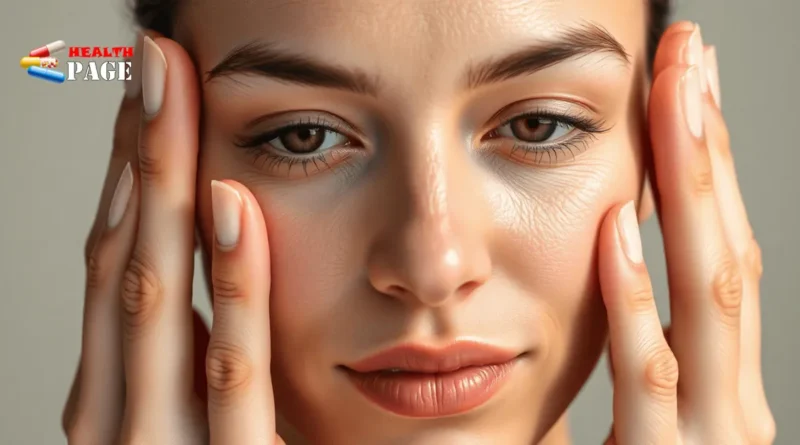How to reverse facial asymmetry from sleeping on side
Do you notice one side of your face looking different from the other? Facial asymmetry might be the culprit behind this common concern. Your sleeping position plays a significant role in shaping facial features over time.
Think of your face as a delicate sculpture that responds to constant pressure. When you sleep on one side night after night, it creates uneven pressure on your facial tissues. This repeated pattern can lead to visible differences between the two sides of your face.
Common causes of facial asymmetry include:
- Genetic predisposition
- Habitual side sleeping
- Muscle imbalances
- Age-related changes
- Injury or trauma
- Medical conditions
Side sleeping remains one of the most controllable factors affecting facial symmetry. The good news? You can take steps to address these changes and work toward a more balanced appearance.
This guide focuses on practical methods to reverse facial asymmetry caused by side sleeping. You’ll discover effective techniques to restore balance to your features. These strategies benefit both your appearance and facial function, from improved jaw alignment to reduced muscle tension.
Understanding Facial Asymmetry
Facial asymmetry stems from multiple factors that shape our unique appearances. Genetic inheritance plays a primary role in determining facial structure, muscle development, and bone formation patterns.
Genetic Influences on Facial Features
Your DNA blueprint influences:
- Bone structure development
- Muscle attachment points
- Tissue distribution
- Natural facial proportions
- Skeletal growth patterns
Impact of Physical Trauma on Symmetry
Physical trauma can disrupt facial symmetry through:
- Sports injuries
- Accidents
- Falls
- Surgical procedures
- Birth complications
Medical Conditions Affecting Balance
Medical conditions significantly impact facial balance:
- Bell’s palsy affects nerve function
- TMJ disorders alter jaw alignment
- Dental malocclusion changes bite patterns
- Developmental conditions affect bone growth
- Infections can cause tissue changes
Aging Effects on Asymmetry
The natural aging process creates asymmetrical changes:
- Muscle tone decreases unevenly
- Fat pads shift position
- Bone density reduces
- Skin elasticity varies
- Gravity effects accumulate
Daily Habits Shaping Symmetry
Daily habits shape facial symmetry through:
- Repetitive expressions
- Chewing preferences
- Head posture
- Sun exposure patterns
- Sleep positions
Lifestyle Choices and Their Impact
Your lifestyle choices directly influence facial symmetry:
- Smoking accelerates aging
- Poor nutrition affects skin health
- Dehydration impacts tissue volume
- Exercise maintains muscle tone
- Stress levels affect muscle tension
Research shows genetic factors account for approximately 60% of facial asymmetry variations. The remaining 40% stems from environmental influences and personal habits.
Understanding these contributing factors helps create targeted strategies for addressing facial asymmetry. Each factor requires specific approaches – from preventive measures to corrective treatments.
Genetic predisposition combines with daily choices to create unique facial features. Simple changes in habits can help maintain natural symmetry despite inherited tendencies.

The Impact of Sleeping Position on Facial Structure
Sleeping on your side can have a lasting impact on the structure of your face. When you consistently sleep in this position, certain areas of your face experience pressure, which can lead to changes over time. This constant compression affects not only the skin but also the muscles and tissues beneath it on the side you prefer to sleep on.
How Side-Sleeping Affects Your Face
According to research published in the Journal of Cosmetic and Laser Therapy, prolonged side-sleeping can result in:
- Deeper wrinkles on the side of your face that comes into contact with the pillow
- Flattening of facial features such as cheeks and lips
- Displacement of facial fat pads, leading to sagging or unevenness
- Uneven development of facial muscles
- Accelerated aging of the skin on the side that is pressed against the pillow
These findings are consistent with what we know about facial skin and how it responds to external pressure.
Study Findings on Chronic Side-Sleepers
In 2021, dermatologists at the University of Michigan conducted a study that examined visible facial asymmetry in individuals who have been sleeping predominantly on one side for five or more years. The research involved tracking 100 participants during this period.
Here are some key findings from their study:
- 78% of participants showed noticeable volume loss on their preferred sleeping side
- 65% developed deeper nasolabial folds (the lines running from the nose to the corners of the mouth) on the compressed side
- 42% experienced uneven jawline definition
Age and Pressure-Induced Changes
As we age, our skin loses its elasticity, making pressure-induced changes more pronounced. On average, when you sleep for eight hours each night in a side-sleeping position, it amounts to approximately 2,920 hours of uneven pressure applied annually to various structures in your face.
Effects on Lymphatic Drainage and Skin Health
Your sleeping position also influences how fluid drains from your face. Side-sleeping has the potential to disrupt proper circulation of lymphatic fluid, which may result in:
- Puffiness in the morning upon waking up
- Uneven texture of your skin
- Accumulation of toxins on one side of your face
- Decreased collagen production in areas that are compressed during sleep
These effects become more pronounced when combined with inadequate support from pillows or sleeping on rough fabric surfaces. Over time, these nightly habits can gradually but significantly shape the symmetry of your face.
Furthermore, there’s evidence suggesting that these pressure-induced changes can be mitigated with proper skincare routines and lifestyle adjustments.
Strategies to Reverse Facial Asymmetry from Side-Sleeping Habits
Breaking the habit of side-sleeping requires dedication and practical adjustments to your sleeping routine. Here’s a comprehensive guide to reverse facial asymmetry from sleeping on side.
Train Yourself to Sleep on Your Back
- Start by placing a pillow under each arm to prevent rolling
- Use a cervical pillow to maintain proper neck alignment
- Position a small pillow under your knees to reduce lower back strain
- Consider using a sleep positioning device designed for back sleeping
Choose the Right Pillow Support
A supportive pillow plays a crucial role in maintaining facial symmetry during sleep:
- Select a pillow with medium firmness
- Look for memory foam or latex materials that contour to your head
- Ensure the pillow height keeps your neck parallel to the mattress
- Replace pillows every 18-24 months to maintain proper support
Implement Gradual Changes
Successful adaptation to new sleep positions requires patience:
- Begin with short naps in the desired position
- Practice lying on your back for 15 minutes before falling asleep
- Use silk or satin pillowcases to reduce facial friction
- Create a bedtime routine that promotes back sleeping
Night-time Facial Support
Additional measures can help protect your facial structure:
- Apply facial tape to support problem areas
- Use specialized facial pillows with cut-outs for side sleeping
- Invest in compression masks designed for sleeping
- Consider night splints if recommended by a healthcare professional
These strategies work best when implemented consistently. Regular practice helps retrain sleep patterns and supports facial symmetry restoration.
Holistic Approaches for Promoting Facial Symmetry
A balanced lifestyle creates the foundation for facial symmetry restoration. Your daily habits directly influence skin health, muscle tone, and tissue regeneration – key factors in addressing facial asymmetry from side sleeping.
Essential Lifestyle Elements for Facial Balance:
- Hydration HabitsDrink 8-10 glasses of water daily
- Limit dehydrating beverages like alcohol and caffeine
- Include hydrating foods such as watermelon, cucumber
- Nutrient-Rich DietVitamin C foods support collagen production
- Omega-3 fatty acids reduce inflammation
- Antioxidant-rich berries protect skin cells
- Zinc-containing foods aid tissue repair
Skin-Supporting Activities:
- Regular facial massage increases blood flow
- Gentle lymphatic drainage reduces fluid retention
- UV protection prevents uneven skin damage
- Quality sleep on a silk pillowcase reduces friction
Your skin requires specific nutrients to maintain elasticity and promote healing. A diet rich in antioxidants helps combat free radical damage that can worsen asymmetry. Foods like sweet potatoes, spinach, and citrus fruits provide essential vitamins for skin repair.
Proper hydration keeps skin cells plump and supports natural detoxification processes. When skin stays hydrated, it maintains better elasticity and recovers more effectively from pressure-induced changes.
Additional Wellness Practices:
- Stress management through meditation
- Regular exercise for improved circulation
- Proper posture throughout the day
- Adequate sleep duration (7-9 hours)
These holistic approaches work together to create an environment where your body can naturally address facial asymmetry. Each element supports your skin’s ability to maintain balance and recover from side-sleeping effects.
For instance, skin circulation benefits can be enhanced through regular exercise which also plays a role in maintaining proper posture throughout the day. Furthermore, managing stress through techniques like meditation can significantly improve overall wellness which in turn aids in achieving facial symmetry.
Additionally, if you’re struggling with issues like bags under your eyes due to side sleeping, there are specific strategies you can employ to alleviate this problem. For expert advice on how to address such concerns, refer to this comprehensive guide on how to get rid of bags under eyes according to the pros.
Facial Exercises and Non-Surgical Treatments for Enhancing Symmetry
Targeted facial exercises offer a natural approach to addressing facial asymmetry through muscle strengthening and balance restoration.
Essential Facial Exercises for Symmetry:
- Cheek Lifts: Press your fingers against your cheeks while smiling to create resistance. Hold for 10 seconds, repeat 15 times.
- Tongue Press: Push your tongue against the roof of your mouth while making a humming sound. Practice for 30 seconds.
- Fish Face: Suck in your cheeks and hold the position for 5 seconds. Perform 20 repetitions daily.
- Face Yoga: Incorporate face yoga into your routine by practicing gentle stretching movements focusing on the less developed side of your face.
These exercises work best when performed consistently, dedicating 10-15 minutes each day to your facial exercise routine.
Non-Surgical Treatment Options:
Dermal fillers stand out as an effective temporary solution for facial asymmetry correction. These injectable treatments can:
- Balance uneven facial features
- Restore lost volume
- Improve facial contours
- Create subtle lifting effects
Additional non-surgical treatments include:
- PDO Thread Lifts: Create subtle lifting effects without surgery
- Botox Injections: Help relax overactive muscles causing asymmetry
- Facial Massage: Stimulate blood flow and reduce muscle tension
- Microcurrent Therapy: Tone facial muscles through gentle electrical stimulation
The effectiveness of these treatments varies among individuals. A consultation with a licensed aesthetician or dermatologist helps determine the most suitable approach for your specific case.
Combining professional treatments with regular facial exercises creates a comprehensive strategy for addressing facial asymmetry. Regular practice strengthens facial muscles, while professional treatments provide immediate visible results. For instance, facial muscle toning can significantly enhance the effectiveness of these exercises, leading to more pronounced results over time.
When to Consider Surgical Interventions for Severe Facial Asymmetry Cases?
Surgical interventions become a viable option when non-invasive methods fail to address significant facial asymmetry concerns.
Key indicators for surgical consultation:
- Visible bone structure irregularities
- Severe muscle imbalances affecting facial expressions
- Asymmetry causing functional issues with eating or speaking
- Persistent asymmetry despite lifestyle changes and non-surgical treatments
A qualified facial plastic surgeon can evaluate the severity of asymmetry through:
- 3D facial mapping
- Detailed medical imaging
- Comprehensive facial structure analysis
- Assessment of muscle and tissue distribution
Common surgical procedures include:
- Facial implants: Custom-designed prosthetics to enhance specific areas
- Orthognathic surgery: Correction of jaw misalignment
- Selective fat transfer: Strategic volume restoration
- Deep plane facelifts: Repositioning of deeper facial tissues
The recovery period typically ranges from 2-6 weeks, depending on the procedure’s complexity.
Surgical success rates are highest when:
- The patient has reached facial maturity
- The asymmetry causes functional limitations
- Conservative treatments have proven insufficient
- The patient maintains realistic expectations
Insurance may cover surgical corrections if the asymmetry impacts essential functions like breathing or chewing.
A thorough consultation with board-certified surgeons helps determine if surgical intervention aligns with individual goals and medical needs.
Conclusion
Reversing facial asymmetry caused by sleeping on your side doesn’t have to feel impossible. Your journey towards a balanced face starts with simple changes to your sleep habits and lifestyle choices.
A combination of these proven methods can make a real difference:
- Switch between sleeping positions
- Use supportive pillows
- Practice facial exercises
- Stay hydrated
- Maintain a balanced diet
- Consider non-surgical treatments
The path to facial symmetry looks different for everyone. Some may see improvements within weeks of changing sleep positions, while others may require professional help.
Remember this: facial asymmetry from side sleeping develops gradually – its reversal also takes time and patience. Listen to your body and work with qualified healthcare professionals to create a personalized plan that suits your needs.
Your face tells your unique story. Whether you choose natural remedies or medical treatments, focus on what makes you feel confident and comfortable in your own skin.
FAQs (Frequently Asked Questions)
What is facial asymmetry and how can sleeping on one side cause it?
Facial asymmetry refers to unevenness or imbalance in the features of the face. It can be caused by various factors including genetics, injury, disease, aging, and lifestyle habits such as habitual side-sleeping. Sleeping predominantly on one side applies prolonged pressure to certain facial areas, potentially leading to structural changes that contribute to facial asymmetry over time.
Which factors besides sleeping position contribute to facial asymmetry?
Apart from sleeping position, facial asymmetry can result from genetics, injuries, diseases, aging processes, and lifestyle habits. Genetics play a significant role in determining an individual’s natural facial symmetry, while lifestyle choices such as diet and hydration also impact skin health and muscle tone that influence overall facial balance.
How can changing sleep positions help reverse facial asymmetry caused by side-sleeping?
Regularly changing sleep positions reduces prolonged pressure on one side of the face, helping to prevent or minimize structural changes that lead to asymmetry. Using supportive pillows designed to maintain proper head and neck alignment further aids in distributing pressure evenly during sleep, promoting better facial symmetry over time.
What holistic lifestyle habits support improving facial symmetry?
Maintaining a healthy lifestyle supports skin elasticity and muscle tone essential for facial symmetry. Key habits include staying well-hydrated, following a balanced diet rich in antioxidants, avoiding excessive sun exposure, managing stress levels, and engaging in regular physical activity. These practices help enhance overall skin health and may reduce the severity of existing facial asymmetry.
Are there non-surgical treatments available to enhance facial symmetry?
Yes, targeted facial exercises can strengthen specific muscles responsible for maintaining balance in the face. Additionally, non-surgical options like dermal fillers offer temporary solutions for mild cases of unevenness by restoring volume and contour. These treatments should be considered alongside professional guidance to ensure safety and effectiveness.
When should someone consider surgical interventions for severe facial asymmetry?
Individuals with significant or persistent facial asymmetry that does not improve with non-invasive methods may benefit from consulting a qualified surgeon. Surgical options such as facelifts or implants can provide more permanent correction. It is important to seek professional evaluation to discuss potential risks, benefits, and appropriate treatment plans tailored to individual needs.


